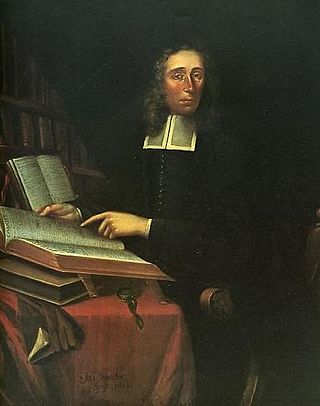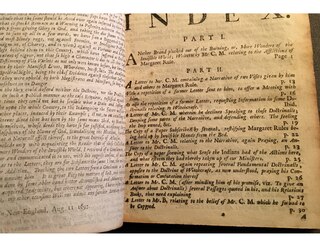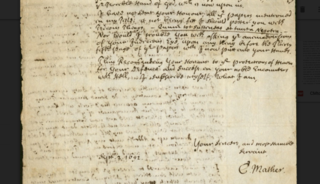Related Research Articles

Cotton Mather was a Puritan clergyman and author in colonial New England, who wrote extensively on theological, historical, and scientific subjects. After being educated at Harvard College, he joined his father Increase as minister of the Congregationalist Old North Meeting House in Boston, Massachusetts, where he preached for the rest of his life. He has been referred to as the "first American Evangelical".

The Wonders of the Invisible World was a book written by Cotton Mather and published in 1693. It was subtitled, Observations As well Historical as Theological, upon the Nature, the Number, and the Operations of the Devils. The book defended Mather's role in the witchhunt conducted in Salem, Massachusetts. It espoused the belief that witchcraft was an evil magical power. Mather saw witches as tools of the devil in Satan's battle to "overturn this poor plantation, the Puritan colony", and prosecution of witches as a way to secure God's blessings for the colony.

The Salem witch trials were a series of hearings and prosecutions of people accused of witchcraft in colonial Massachusetts between February 1692 and May 1693. More than 200 people were accused. Thirty people were found guilty, nineteen of whom were executed by hanging. One other man, Giles Corey, died under torture after refusing to enter a plea, and at least five people died in jail.

Increase Mather was a New England Puritan clergyman in the Massachusetts Bay Colony and president of Harvard College for twenty years (1681–1701). He was influential in the administration of the colony during a time that coincided with the notorious Salem witch trials.
Spectral evidence is a form of legal evidence based upon the testimony of those who claim to have experienced visions.
Michael Wigglesworth (1631–1705) was a Puritan minister, physician, and poet whose poem The Day of Doom was a bestseller in early New England.

Richard Mather was a New England Puritan minister in colonial Boston. He was father to Increase Mather and grandfather to Cotton Mather, both celebrated Boston theologians.

Sir William Phips was born in Maine in the Massachusetts Bay Colony and was of humble origin, uneducated, and fatherless from a young age but rapidly advanced from shepherd boy to shipwright, ship's captain, and treasure hunter, the first New England native to be knighted, and the first royally appointed governor of the Province of Massachusetts Bay. Phips was famous in his lifetime for recovering a large treasure from a sunken Spanish galleon but is perhaps best remembered today for establishing the court associated with the infamous Salem Witch Trials, which he grew unhappy with and was forced to prematurely disband after five months.

Samuel Parris was the Puritan minister in Salem Village, Massachusetts, during the Salem witch trials. He was also the father of one of the afflicted girls, and the uncle of another.

George Burroughs was a non-ordained Puritan preacher who was the only minister executed for witchcraft during the course of the Salem witch trials. He is remembered especially for reciting the Lord's Prayer during his execution, something it was believed a witch could never do.

Goody Ann Glover was an Irish former indentured servant and the last person to be hanged in Boston as a witch, although the Salem witch trials in nearby Salem, Massachusetts, occurred mainly in 1692.
This timeline of the Salem witch trials is a quick overview of the events.

The Bury St Edmunds witch trials were a series of trials conducted intermittently between the years 1599 and 1694 in the town of Bury St Edmunds in Suffolk, England.

Robert Calef was a cloth merchant in colonial Boston. He was the author of More Wonders of the Invisible World, a book composed throughout the mid-1690s denouncing the recent Salem witch trials of 1692–1693 and particularly examining the influential role played by Cotton Mather.
Deodat Lawson was a British American minister in Salem Village from 1684 to 1688 and is famous for a 10-page pamphlet describing the witchcraft accusations in the early spring of 1692. The pamphlet was billed as "collected by Deodat Lawson" and printed within the year in Boston, Massachusetts.

First Church in Boston is a Unitarian Universalist Church founded in 1630 by John Winthrop's original Puritan settlement in Boston, Massachusetts. The current building, located on 66 Marlborough Street in the Back Bay neighborhood, was designed by Paul Rudolph in a modernist style after a fire in 1968. It incorporates part of the earlier gothic revival building designed by William Robert Ware and Henry Van Brunt in 1867. The church has long been associated with Harvard University.
Sarah Cloys/Cloyce was among the many accused during Salem Witch Trials including two of her older sisters, Rebecca Nurse and Mary Eastey, who were both executed. Cloys/Cloyce was about 50-years-old at the time and was held without bail in cramped prisons for many months before her release.
The Cambridge Association was an influential group of Congregational clergymen in the Boston area who regularly met in the Harvard College library between 1690 and 1697. The minutes of their meetings shed important light on the oft-debated question of the Puritan ministers influence on the witchcraft trials.

In a letter dated September 2, 1692, Cotton Mather wrote to judge William Stoughton. Among the notable things about this letter is the provenance: it seems to be the last important correspondence from Mather to surface in modern times, with the holograph manuscript not arriving in the archives for scholars to view, and authenticate, until sometime between 1978 and 1985.
References
- ↑ Landrigan, Leslie (2017-10-04). "Mary Webster, the Witch of Hadley, Survives a Hanging". New England Historical Society. Retrieved 2023-06-05.
- ↑ Transactions of the Colonial Society of Massachusetts (Dec. 1904) p.22. citing Records of the Court of Assistants i.228,229. One online version is here:-- https://play.google.com/books/reader?id=c8_kAAAAMAAJ&pg=GBS.PA22
- 1 2 3 4 The History of the Province of Massachusetts-Bay: From the Charter ... In 1691, Until the Year 1750. By Mr. Hutchinson, ... Vol.II. J. Smith. 1768.
- ↑ https://play.google.com/books/reader?id=cmxjAAAAcAAJ&pg=GBS.PA54 See second example. Also another edition here: http://quod.lib.umich.edu/e/evans/N00392.0001.001?rgn=subject;view=toc;q1=Witchcraft
- ↑ Memorable Providences, relating to Witchcrafts and Possessions ... With an appendix, in vindication of a chapter in a late book of remarkable providences, etc. 1691.
- ↑ Remarkable Providences Illustrative of the Earlier Days of American Colonisation. Reeves and Turner. 1890. ISBN 9780598980533.
- ↑ "Site Maintenance". Archived from the original on 2019-09-03. Retrieved 2019-09-16.
- ↑ The Witchcraft Delusion in New England: More wonders of the invisible world, collected by R. Calef. W. Elliot Woodward. 1866.
- ↑ Massachusetts Historical Society (1879–1997). Proceedings of the Massachusetts Historical Society. Boston: The Society.
- ↑ "Mary (Reeve) Webster". faculty.uml.edu. Retrieved 2023-06-05.
- ↑ Calef's letter is dated November 24, 1693, according to his own reprint of it. https://play.google.com/books/reader?id=ez74xEMY5vwC&pg=GBS.PA58 GL Burr also reprinted an abridged version of Calef's book including the November letter to Mather, https://play.google.com/books/reader?id=4hgOAAAAIAAJ&pg=GBS.PA331
- ↑ Mather, Cotton (February 2006). Memorable providences, relating to witchcrafts and possessions. A faithful account of many wonderful and surprising things, that have befallen several bewitched and possessed persons in New-England. Particularly, a narrative of the marvellous trouble and releef [sic] experienced by a pious family in Boston, very lately and sadly molested with evil spirits. : Whereunto is added, a discourse delivered unto a congregation in Boston, on the occasion of that illustrious providence. : As also a discourse delivered unto the same congregation; on the occasion of an horrible self-murder committed in that town. : With an appendix, in vindication of a chapter in a late book of remarkable providences, from the calumnies of a Quaker at Pen-silvania [sic]. / Written by Cotton Mather, Minister of the Gospel. ; And recommended by the Ministers of Boston and Charleston.
- ↑ Magnalia Christi Americana: Book 4. Sal gentium. 1853. Book 5. Acts and monuments. 1853. Book 6. Thaumaturgus. 1853. Book 7. Ecclesiarum prælia. 1853. S. Andrus and son. 1853.
- ↑ "Margaret Atwood, the Prophet of Dystopia". The New Yorker . 10 April 2017.